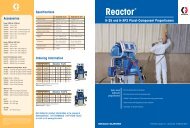Acry-Tek 4200 / SPF Recoat System - Coating & Foam Solutions, LLC
Acry-Tek 4200 / SPF Recoat System - Coating & Foam Solutions, LLC
Acry-Tek 4200 / SPF Recoat System - Coating & Foam Solutions, LLC
Create successful ePaper yourself
Turn your PDF publications into a flip-book with our unique Google optimized e-Paper software.
B. Minimum Application Thickness:<br />
1. Application rates must be checked periodically to assure<br />
proper coating thickness. This may be done with a wet<br />
film gauge or by checking coverage of a known quantity.<br />
(i.e. 5 gallons covers 333 sq.ft. (4’x83’) or. 7 ½ gallons<br />
covered 500 sq.ft. (Both examples = 1 ½ gallons per<br />
square.)<br />
2. Each contactor should estimate coating requirements<br />
based on actual experience and needs to figure losses<br />
due to applicator experience, surface texture, wind,<br />
waste, and other factors increasing estimated gallons<br />
required.<br />
3. The total dry mil thickness of all coatings, as well as the<br />
total dry mil thickness of the topcoat(s) shall meet the<br />
minimums required by CFS.<br />
4. Apply base/intermediate coat(s) to achieve the nominal<br />
film thickness required. Double coat flashing and edge<br />
termination. Refer to ”Application” section of Technical<br />
Data Bulletins for application instructions.<br />
C. Installation of Protective Base <strong>Coating</strong> on New <strong>Foam</strong><br />
1. Apply intermediate coat of contrasting color to a<br />
minimum thickness of 16 TDM (Total Dry Mils). The<br />
intermediate coat shall completely cover the base coat<br />
including expansion joint covers, parapets and flashing.<br />
Refer to “Application" section of Technical Data<br />
Bulletins for application instructions.<br />
D. Installation of Protective Top <strong>Coating</strong>(s)<br />
1. Apply top coat(s) to a minimum thickness of 16 TDM<br />
(Total Dry Mils). The final color shall be from the CFS<br />
standard color chart. The top coat(s) shall completely<br />
cover the base or intermediate coat(s) including<br />
expansion joint covers, parapets and flashing. Refer to<br />
”Application” section of Technical Data Bulletins for<br />
application instructions.<br />
4.4 3.04 INSTALLATION OF WALKWAYS AND GRANULES.<br />
A. In high-traffic areas and around mechanical equipment,<br />
walkways should be installed to protect the coating system<br />
from damage.<br />
B. When required, broadcast granules into wet topcoat to fully<br />
cover at a minimum rate of 35-40 lbs per 100 sq. ft.<br />
4.5 3.05. JOB COMPLETION<br />
A. Inspect completed roofing system and correct all defects to<br />
meet the specification and/or warranty requirements.<br />
1. Transparent or thin areas: if areas appear to be<br />
undercoated, recoating may be needed to ensure final<br />
thickness to meet the CFS specifications.<br />
2. Delamination: Verify that all coated areas appear to be<br />
fully adhered to the substrate. A visual inspection<br />
looking for typical signs of poor adhesion such as<br />
flaking, blistering etc. should be made. Re-priming<br />
and/or recoating will be required if such areas are<br />
apparent.<br />
3. Pin Holing: Certain job or site conditions may result in<br />
pin holing or out gassing during curing or pin holes in<br />
the substrate. Again, a visual inspection looking for<br />
typical signs of out gassing such as excessive<br />
pockmarks, pinholes etc. should be done.<br />
4. Lifting: This wrinkled appearance is caused when<br />
freezing of water-based coatings, off ratio or poorly<br />
mixed plural component coating, or solvent entrapment<br />
in solvent based coatings. The coating surface may<br />
exhibit extreme wrinkles, small blisters and may have<br />
loss of adhesion. These areas will not “self heal” and<br />
must be removed, power washed and new coating must<br />
be applied.<br />
5. Texturized Finish: Heavy patterns, blistering,<br />
B.<br />
“skinning,” etc. may appear in the final finish. These<br />
may be indicators that too thick a coat or a build-up has<br />
occurred or other application problems. Check with CFS<br />
for remedial advice.<br />
6. Wash-off: (when the acrylic coating is not allowed to<br />
cure thoroughly): Wash-off (chalk-like in appearance)<br />
may occur if rain or moisture comes in contact with<br />
water-based coatings during or prior to curing. If washoff<br />
occurs, the affected area must be power washed to<br />
remove coating residue prior to reapplying the acrylic<br />
coating.<br />
7. Snow-flaking, Feathering, and Spider Webbing: This<br />
is an appearance that the finished coating may exhibit<br />
when water-based coating is applied and the surface<br />
reaches freezing temperatures before the coating is fully<br />
cured. This normally occurs within a 24-hour period<br />
from the time of application. Generally these areas will<br />
“self heal” when exposed to heat and sunlight. In event<br />
that they would not self heal, the affected surface must<br />
be power washed, and new coating must be reapplied.<br />
An independent inspector will inspect the completed roofing<br />
system and notify the Contractor of any defects in the<br />
application.<br />
C. Clean up all debris, excess materials, and equipment and<br />
remove from site.<br />
D. Restrict construction traffic and equipment movement on the<br />
completed roofing system to only essential personnel.<br />
Provide appropriate protection against traffic and<br />
construction activities on completed roofs. Damage to the<br />
roof by other trades shall not be the responsibility of the<br />
CFS Roofing Applicator.<br />
End of Section<br />
Copyright© 2010<br />
Roof-<strong>Tek</strong>® WATERPROOF BY DESIGN ISSUE:<br />
The Engineered Roofing Resource Page 4 January 5, 2009



